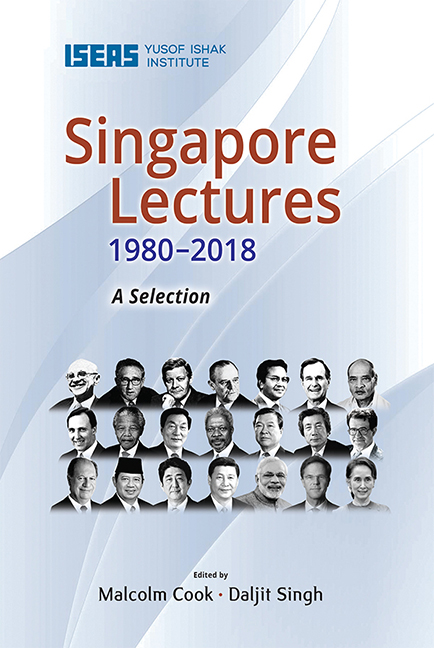Book contents
- Frontmatter
- Contents
- Introduction
- 1 The Invisible Hand in Economics and Politics
- 2 American Foreign Policy: A Global View
- 3 The Soviet Union: Challenges and Responses as Seen from the European Point of View
- 4 Trends in the International Financial System
- 5 Regionalism, Globalism and Spheres of Influence: ASEAN and the Challenge of Change into the 21st Century
- 6 US Policy in the Asia-Pacific Region: Meeting the Challenges of the Post-Cold War Era
- 7 India and the Asia-Pacific: Forging a New Relationship
- 8 Australia, Asia and the New Regionalism
- 9 South and Southern Africa into the Next Century
- 10 China and Asia in the New Century
- 11 Global Values: The United Nations and the Rule of Law in the 21st Century
- 12 Peace on the Korean Peninsula and East Asia
- 13 Japan and ASEAN in East Asia: A Sincere and Open Partnership
- 14 EU and Asia: Sharing Diversity in an Inter-regional Partnership
- 15 Global Challenges in the 21st Century: A View from Chile
- 16 Indonesia: The Challenge of Change
- 17 Japan and ASEAN, Always in Tandem: Towards a More Advantageous Win-Win Relationship through My “Three Arrows”
- 18 Forging a Strong Partnership to Enhance Prosperity of Asia
- 19 India’s Singapore Story
- 20 The Netherlands, Singapore, Our Regions, Our World: Connecting Our Common Future
- 21 Democratic Transition in Myanmar: Challenges and the Way Forward
- The Singapore Lecture Series
- The Editors
1 - The Invisible Hand in Economics and Politics
Published online by Cambridge University Press: 09 October 2021
- Frontmatter
- Contents
- Introduction
- 1 The Invisible Hand in Economics and Politics
- 2 American Foreign Policy: A Global View
- 3 The Soviet Union: Challenges and Responses as Seen from the European Point of View
- 4 Trends in the International Financial System
- 5 Regionalism, Globalism and Spheres of Influence: ASEAN and the Challenge of Change into the 21st Century
- 6 US Policy in the Asia-Pacific Region: Meeting the Challenges of the Post-Cold War Era
- 7 India and the Asia-Pacific: Forging a New Relationship
- 8 Australia, Asia and the New Regionalism
- 9 South and Southern Africa into the Next Century
- 10 China and Asia in the New Century
- 11 Global Values: The United Nations and the Rule of Law in the 21st Century
- 12 Peace on the Korean Peninsula and East Asia
- 13 Japan and ASEAN in East Asia: A Sincere and Open Partnership
- 14 EU and Asia: Sharing Diversity in an Inter-regional Partnership
- 15 Global Challenges in the 21st Century: A View from Chile
- 16 Indonesia: The Challenge of Change
- 17 Japan and ASEAN, Always in Tandem: Towards a More Advantageous Win-Win Relationship through My “Three Arrows”
- 18 Forging a Strong Partnership to Enhance Prosperity of Asia
- 19 India’s Singapore Story
- 20 The Netherlands, Singapore, Our Regions, Our World: Connecting Our Common Future
- 21 Democratic Transition in Myanmar: Challenges and the Way Forward
- The Singapore Lecture Series
- The Editors
Summary
Milton Friedman, Nobel laureate in economics and Professor of Economics at the University of Chicago, delivered the inaugural Singapore Lecture on 14 October 1980. He was introduced to the audience by Singapore Deputy Prime Minister Dr Goh Keng Swee. A proponent of free market capitalism with minimal governmental involvement, Professor Friedman's influential ideas helped to move economic consensus to the right, leading to the free market revolutions in Britain and America in the 1980s. They also had strong influence in other parts of the world. Professor Friedman's lecture, followed by a Q&A session, was a stimulating exposition of his ideas.
I am going to talk tonight about some very broad issues, but issues that I believe have a direct bearing on the prospects of much of the world over the coming decade. My comments will be divided into three parts. I want to talk, first, about the changing trends that have dominated developments in the world over the past several centuries, and that I think foreshadow the developments that we shall see in the coming decades. I want then to examine a bit more carefully the nature of the forces that produced those trends; finally, I want to conclude by looking at what developments are likely in coming decades in response to those forces.
In 1899, a famous British constitutional lawyer, A.V. Dicey, gave a series of lectures at Harvard University, which were later collected and published in a book under the title: Lectures on the Relation between Law and Public Opinion in the Nineteenth Century. That book contains a profound analysis of the forces that determine the government policies and of the role of public opinion in shaping those policies. Dicey's main thesis was that legislation affecting public policy follows public opinion but only after a long lag. If public opinion moves, then some ten or twenty years later, that movement in public opinion is reflected in policy. This idea was expressed later in a famous paragraph by John Maynard Keynes when he talked of “madmen in authority … distilling their frenzy from some academic scribbler of a few years back”.
- Type
- Chapter
- Information
- Singapore Lectures 1980-2018 , pp. 1 - 18Publisher: ISEAS–Yusof Ishak InstitutePrint publication year: 2020

